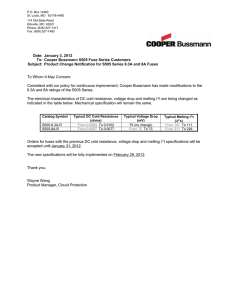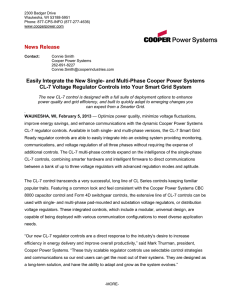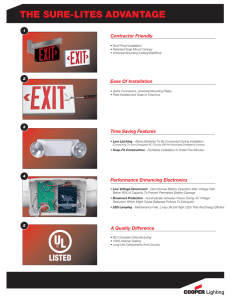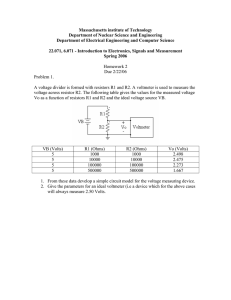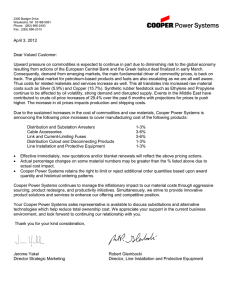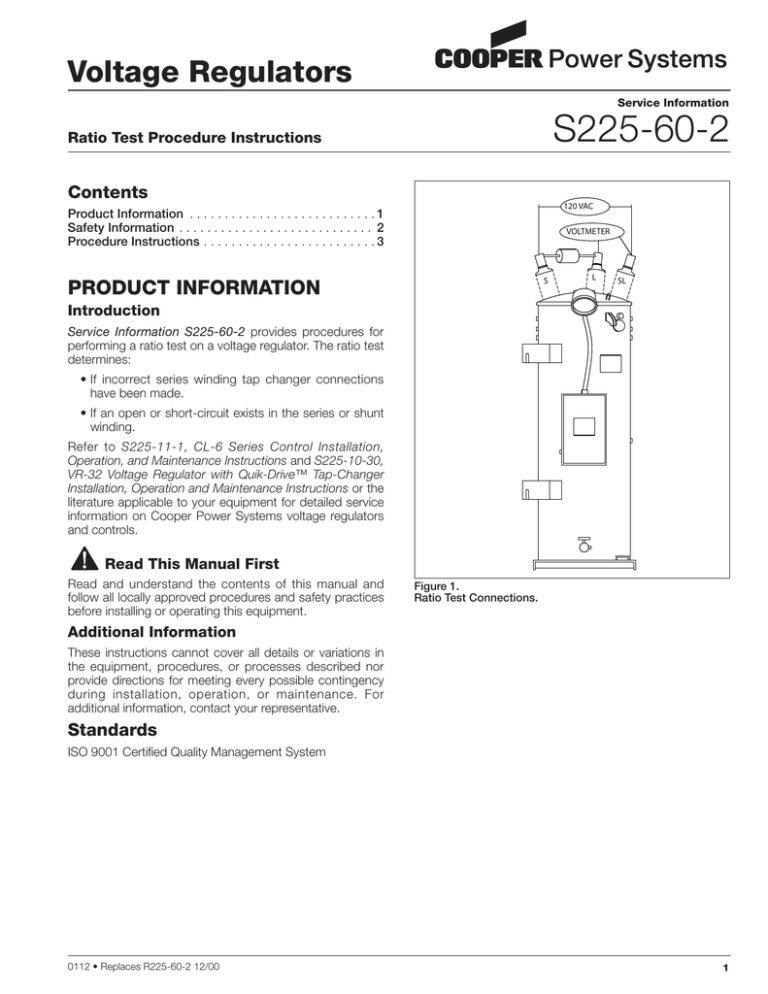
Voltage Regulators
Service Information
S225-60-2
Ratio Test Procedure Instructions
Contents
120 VAC
Product Information . . . . . . . . . . . . . . . . . . . . . . . . . . . 1
Safety Information �������������������������������������������������������� 2
Procedure Instructions . . . . . . . . . . . . . . . . . . . . . . . . . 3
VOLTMETER
S
Product Information
L
SL
Introduction
Service Information S225-60-2 provides procedures for
performing a ratio test on a voltage regulator. The ratio test
determines:
•If incorrect series winding tap changer connections
have been made.
•If an open or short-circuit exists in the series or shunt
winding.
Refer to S225-11-1, CL-6 Series Control Installation,
Operation, and Maintenance Instructions and S225-10-30,
VR-32 Voltage Regulator with Quik-Drive™ Tap-Changer
Installation, Operation and Maintenance Instructions or the
literature applicable to your equipment for detailed service
information on Cooper Power Systems voltage regulators
and controls.
!
Read This Manual First
Read and understand the contents of this manual and
follow all locally approved procedures and safety practices
before installing or operating this equipment.
Figure 1.
Ratio Test Connections.
Additional Information
These instructions cannot cover all details or variations in
the equipment, procedures, or processes described nor
provide directions for meeting every possible contingency
during installation, operation, or maintenance. For
additional information, contact your representative.
Standards
ISO 9001 Certified Quality Management System
0112 • Replaces R225-60-2 12/00
1
Ratio Test Procedure Instructions
!
SAFETY
FOR LIFE
SAFETY FOR LIFE
!
SAFETY
FOR LIFE
Cooper Power Systems products meet or exceed all applicable industry standards relating to product safety. We actively
promote safe practices in the use and maintenance of our products through our service literature, instructional training
programs, and the continuous efforts of all Cooper Power Systems employees involved in product design, manufacture,
marketing and service.
We strongly urge that you always follow all locally approved safety procedures and safety instructions when working
around high-voltage lines and equipment and support our “Safety For Life” mission.
SAFETY Information
The instructions in this manual are not intended as a
sub­s titute for proper training or adequate experience
in the safe operation of the equipment described.
Only competent technicians, who are familiar with this
equipment should install, operate and service it.
A competent technician has these qualifications:
nIs thoroughly familiar with these instructions.
nIs trained in industry-accepted high- and low-voltage
safe operating practices and procedures.
nIs trained and authorized to energize, de-energize, clear,
and ground power distribution equipment.
nIs trained in the care and use of protective equipment
such as flash clothing, safety glasses, face shield, hard
hat, rubber gloves, clampstick, hotstick, etc.
Following is important safety information. For safe
installation and operation of this equipment, be sure to
read and understand all cautions and warnings.
Hazard Statement Definitions
This manual may contain four types of hazard
statements:
!
DANGER:
Indicates a hazardous situation which, if not
avoided, will result in death or serious injury.
!
WARNING:
Indicates a hazardous situation which, if not
avoided, could result In death or serious injury.
!
CAUTION:
Indicates a hazardous situation which, if not
avoided, could result in minor or moderate injury.
Caution: Indicates a hazardous situation which,
if not avoided, could result in equipment damage
only.
2
Safety Instructions
Following are general caution and warning statements that
apply to this equipment. Additional statements, related to
specific tasks and procedures, are located throughout the
manual.
!
DANGER:
Hazardous voltage. Contact with high voltage will
cause death or severe personal injury. Follow all
locally approved safety procedures when working
around high- and low-voltage lines and equipment.
!
WARNING:
Before installing, operating, maintaining, or testing
this equipment, carefully read and understand
the contents of this manual. Improper operation,
handling or maintenance can result in death, severe
personal injury, and equipment damage.
!
WARNING:
This equipment is not intended to protect human
life. Follow all locally approved procedures and
safety practices when installing or operating this
equipment. Failure to comply may result in death,
severe personal injury and equipment damage.
!
WARNING:
Power distribution and transmission equipment
must be properly selected for the intended
application. It must be installed and serviced
by competent personnel who have been trained
and understand proper safety procedures. These
instructions are written for such personnel and
are not a substitute for adequate training and
experience in safety procedures. Failure to properly
select, install or maintain power distribution and
transmission equipment can result in death, severe
personal injury, and equipment damage.
!
S225-60-2
SAFETY
FOR LIFE
procedure instructions
1. Ensure that the regulator operates correctly. Operate
the regulator as outlined in S225-10-30, "Periodic
Inspections" or S225-11-1, "Operations Check", if in
doubt.
2. Connect a voltmeter between the "L" and "SL"
bushing terminals.
3. Use a variac to apply 120 VAC between the source
(S) and source-load (SL) bushing terminals, as shown
in Figure 1.
Caution: Electrical Shock Hazard. Connecting
an energized variac to the bushings will expose
the tester to 120 VAC. Contact with the bushings will
result in an electrical shock.
!
4. Connect a separate 120 VAC supply to the external
source terminals on the control front panel. Move
the control power switch to the external position
to operate the tap changer. For instruction on
connecting the control to an external source, see
S225-11-1, Connecting Power to External Source
Terminals section.
WARNING: Electrical Shock Hazard. The V1 and
V6 (if present) knife-blade switches must be open
when connecting external power to the control. If 120 VAC
is incorrectly applied to the voltmeter terminals and the
V1 and V6 switches remain closed, rated voltage will be
created on the bushings. Contact with the bushings in
such a case could result in death or serious injury.
!
Caution: Incorrect connection of an external power
source to the control or supply of an over-voltage will
result in damage to the control panel.
5. Increase the voltage on the variac to 120 VAC. This
will provide 12 volts on the series winding.
120 VAC x 10% regulation = 12 volts
6. Calculate the change in volts per tap change as
follows:
TABLE 1
Typical meter readings with 120 VAC connected
between the S and SL bushings
Lower
Raise
16L
108.0
16R
132.0
15L
108.75
15R
131.25
14L
109.5
14R
130.5
13L
110.25
13R
129.75
12L
111.0
12R
129.0
11L
111.75
11R
128.25
10L
112.50
10R
127.5
9L
113.25
9R
126.75
8L
114.0
8R
126.0
7L
114.75
7R
125.25
6L
115.5
6R
124.50
5L
116.25
5R
123.75
4L
117.0
4R
123.0
3L
117.75
3R
122.25
2L
118.5
2R
121.5
1L
119.25
1R
120.75
Neutral
120
7. Operate the tap changer with the control switch
through all 32-steps from 16R to 16L. Record the
voltmeter reading at each tap position. The change
in voltage should be almost the same between each
step (± 0.10 volts). If a substantial difference in any
reading exists, then there is a problem with the
windings or their connection. Readings will be the
same with or without the equalizer winding.
Note: On a type B regulator, the difference between
the taps will be slightly less than calculated
as the regulator is tapped toward 16 lower.
This is normal and inherent in the design of
the type B regulator.
Questions about the described procedure may be directed
to your Cooper Power Systems Representative.
series winding volts = 12 = 0.75 volts per step
16 steps
16
Note: If 160 VAC is applied between the S and SL
bushings, and the calculations in item 5 and
6 are computed, you will see that a 1.0 volt
difference between steps will result. Doing
this will simplify the ratio check.
3
Ratio Test Procedure Instructions
!
SAFETY
FOR LIFE
© 2012 Cooper Industries. All Rights Reserved.
Cooper Power Systems and Quik-Drive are valuable trademarks of Cooper Industries
in the U.S. and other countries. You are not permitted to use the Cooper Trademarks
without the prior written permission of Cooper Industries.
One | www.cooperpower.com | Online
S225602 Rev. 0 (Replaces R225602 12/00)
2300 Badger Drive
Waukesha, WI 53188 USA

